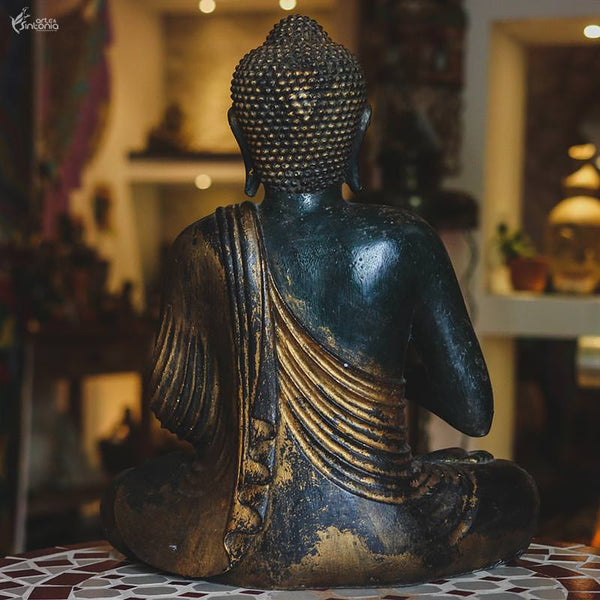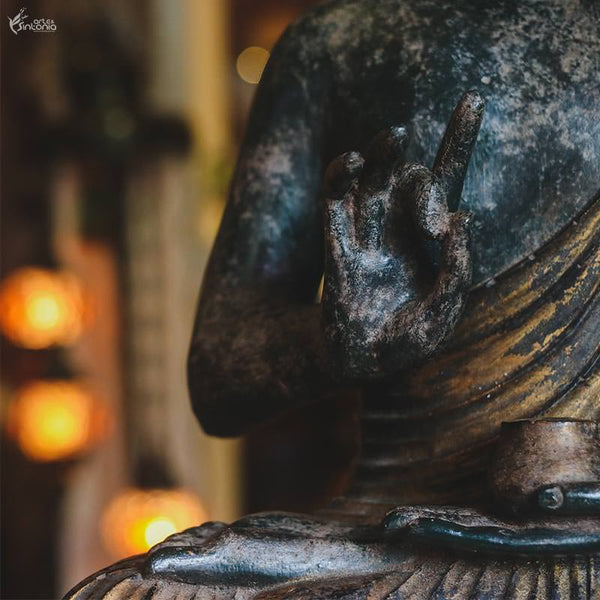There is a lot of questioning about the types of Buddha and the meanings that the images carry. And although they are all capable of stimulating positivity and well-being, wherever they are, the combination of elements that compose them can guide the spiritual connection in a deeper way, directed towards a certain intention. In this way, the variation of Buddha's iconographies will not only be a differentiating factor, but also a leading one for certain environments or spiritual, emotional and physical yearnings.
In order to choose Buddhist art, it is necessary to understand the meanings of the Buddha , as well as to look at yourself in full to understand what needs to be motivated with your image. The stimuli can be healing , fearlessness, peace, abundance, detachment, compassion, wisdom , among many others that change from each detail of the sculpture, from the shape of the head to the posture, as we list below!
Buddha head with ushnisha and curly or bald hair

Usnisa is the bulge on Buddha's head that features in one of his 32 iconographies.
According to passages from the Sutta Digha Nikaya , an ancient Buddhist scripture, the image of Siddhartha Gautama would not differ from most monks who detach from materiality, and therefore would be bald. However, the physical characteristic generated cultural conflicts, especially with the Hindu priestly caste, the Brahmins , who do not consider the lack of hair portrayed in Buddhist art to be auspicious.
In this context, the figure of the master of Zen Buddhism with wavy hair and a protuberance at the top of the Buddha's head , the Usnisa or Ushnisha , emerged; as the Indologist and Buddhist Hans Wolfgang Schumann bases in his bibliography. This symbol of the light of knowledge came to the fore in the Gandara Kingdom , between the 1st and 2nd centuries BCE, with the artistic influence of the Greco-Bactrian Kingdom.
Following this reading, iconographic representations of the Buddha left human characteristics and became more deific. And the Ushnisha , in turn, became one of the 32 symbolic iconographies associated with the trajectory of the Historical Buddha . Still, these obvious differences in the visual arts serve to give birth to two views of the Buddha : as a human and as a deity.
Types of monastic robes and the strands of Buddhism

The kasaya type of robe highlights the different schools of Buddhism.
The monastic robe of Buddhist monks , also depicted in decorative art with images of the Buddha , underwent changes over the centuries as Buddhism was introduced in different countries. Different cultures brought new perspectives to the Buddha 's religious philosophy and new schools were created with particular beliefs and symbols, although they had the same origin.
Clothing, therefore, also underwent variations according to the schools of Buddhism . Yet they all convey the essence of simplicity, reverence, and selflessness. Clothes made from discarded tattered items gave way to clothes made from fabric donations during ceremonies such as Kathina . These are dyed with spices ( curry , paprika, cumin, saffron, etc.) which give the well-known yellowish or orange tone.
The traditional monastic robe is called Tricivara or Kasaya , and is made up of three pieces that can be used independently according to the occasion. The inner cloth ( Antaravasaka ), is a type of skirt supported by a belt from the 18th century; while the upper fabric ( Uttarasanga ), resembles a tunic covering only one shoulder (normally the right shoulder is uncovered) and is the most featured in sculptures ; the outer fabric ( Sanghati ), is a cape style that covers the left shoulder.
In Theravada Buddhism , dominant in Thailand , Cambodia and Sri Lanka, monks present themselves with simplicity following the same Kasaya as the Buddha. In the branch of Mahayana Buddhism , present in China , Japan and Korea, in turn, use the Uttarasanga tunic with wide and long sleeves, due to the climatic conditions. In the Vajrayana Buddhist tradition , which is prevalent in Tibet , the clothing of Tibetan monks and Buddhas is more ornate, including embroidery, colored details, and accessories.
Standing, walking, sitting or reclining Buddha sculpture

Seated Buddha is the most represented in Buddhism and alludes to the state in meditation or teaching.
The posture exhibited by the Buddha is usually determined by standing, walking, sitting or reclining (lying down) - although some types of Buddha , particularly the seated ones, do exhibit yoga postures ( asanas ). They show stages of his trajectory in earthly life until accessing enlightenment. Therefore, when in the standing position , Zen art demonstrates the moment when, after meditating, the Buddha stands up ready to teach the 4 Noble Truths with his feet firmly on the ground. Decorative sculpture highlights the divinity's firmness and repels internal conflicts.
The walking Buddha is the less usual representation, originating from the Sukhothai Era , and it shows the detachment from earthly ties and the beginning of his journey of enlightenment. As a consequence, Buddhist decoration with this image inspires peace and blessings. The seated Buddha emphasizes the importance of meditation for spiritual evolution and access to higher stages of consciousness. It is the most reproduced and diversified Buddha image, whose purpose varies according to the mudra that accompanies it. Virasana , Padmasana and Lalitasana are some of the most common seated poses.
The reclining Buddha is called Parinirvana and demonstrates the final stage in the life of Gautama Buddha , the Historical Buddha . The reclining or sleeping lion posture ( sihasaiyas ) characterizes the transitional state that precedes the attainment of enlightenment or Nirvana , when one is freed from the Cycle of Samsara (continuous flow of birth, old age, illness and death).
Fat or thin Buddha image

Fat Buddha refers to Hotei while his thin appearance embodies Siddhartha Gautama.
One must understand that Buddha is not a single figure, the title configures the enlightened nature of the being and that is why Hotei (or Budai ), one of the Seven Lucky Gods , is also called the Fat Buddha or Smiling Buddha. In Chinese culture, it is believed that he was a Buddhist monk of the Liang Dynasty , whose good humor, magnanimity and full satisfaction made him reach Nirvana . The large belly is an icon of the great compassion and generosity present in its essence.
The slimmer figure, however, is a portrait of Siddhartha , the Supreme Buddha , whose teachings founded Buddhism and its branches. In earthly life, around 2500 years ago, he was a prince who abdicated the trunk in search of answers to the suffering of humanity. This trajectory of spiritual development made him access divine wisdom, which is in everything that exists, and become enlightened. His image in Buddhist art is considered hypostasis , that is, endowed with spiritual powers.
Buddha hands with mudras or buddhist accessories

Like symbolic gestures, Buddhist accessories show the meaning of the Buddha statue.
The presence of mudras, as well as the postures, marks the moment in Buddha's history and the teaching linked to it. This set is crucial to identify not only the type of Buddha that decorative art assumes, but also the energy that vibrates in it. Some sculptures restrict the conception of hands with symbolic gestures ( mudras ), others merge them with accessories from Buddhist practice and philosophy - which also show paths with their meanings.
The Medicine Buddha ( Bhaiṣajyaguru ), for example, is depicted holding a medicinal pot ( Yakko ), containing dharma nectar, in one hand, while the other demonstrates the symbolic gyan mudra gesture. Nevertheless, there is a diversity of Buddhist symbols and accessories represented in the arts. The japamala , the lotus flower , the dharma wheel , the bodhi tree , are the most portrayed.
More detailed works and/or with colorful paintings also help to understand the central message of Zen art . The Medicine Buddha himself is also interpreted with the color blue , relating him to healing powers and the physical, mental and spiritual balance provided by his image. Since there are colorful Buddhas of all types, from solid colors to artistic paintings , to match your purpose and the decoration of your environment.
Visit our virtual store and choose a type of Buddha that fits you. Let your essence be your guide!
Namaste!
Milene Sousa - Art & Tune











1 comment
Excelente ! Explicado de forma didática e muito clara. Adorei! Mas tenho uma pergunta: tem imagens de Buda associado aos dias da semana? E por quê?
Namastê!